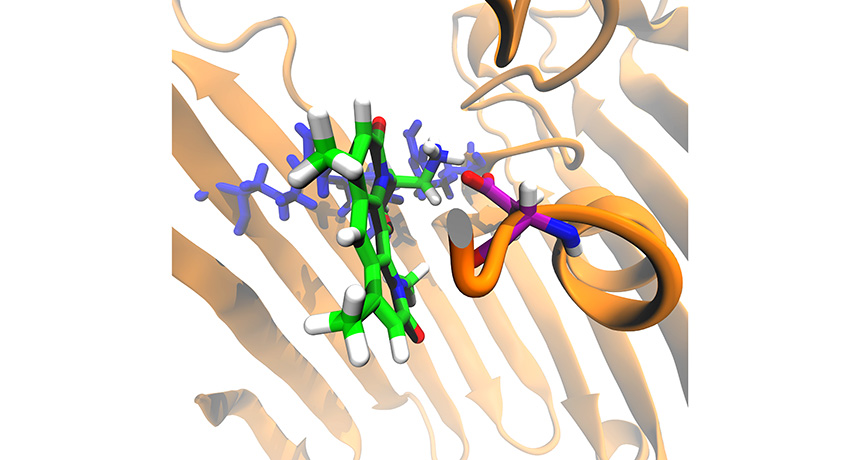New rules for cellular entry may aid antibiotic development
Tests show clues to fighting drug-resistant gram-negative bacteria

MAKE WAY An antimicrobial (mostly green and white in this illustration) that has been modified to target gram-negative bacteria travels through a channel (brown) on its way inside an E. coli cell.
M.F. Richter et al/Nature 2017
- More than 2 years ago
Like entry to an exclusive nightclub, getting inside a gram-negative bacterial cell is no easy feat for chemical compounds. But now a secret handshake has been revealed: A new study lays out several rules to successfully cross the cells’ fortified exteriors, which could lead to the development of sorely needed antibiotics.
“It’s a breakthrough,” says microbiologist Kim Lewis of Northeastern University in Boston, who was not involved with the work. The traditional way to learn how compounds get across the bacterial barrier is to study the barrier, he says. “They decided to attack the problem from the other end: What are the properties of the molecules that may allow them to penetrate across the barrier?” The work describing these properties is published online in Nature on May 10.
Escherichia coli and other gram-negative bacteria — so described because of how they look when exposed to a violet dye called a gram stain — have two cellular membranes. The outer membrane is impermeable to most antibiotics, says Paul Hergenrother, a chemical biologist at the University of Illinois at Urbana-Champaign. “Even if a drug might be really good at killing that gram-negative pathogen, it may not be able to get in the bacteria,” he says.
Many antibiotics that have been effective against gram-negative bacteria are becoming unreliable, as the bugs have developed resistance (SN: 10/15/16, p. 11). To encourage drug development, in February the World Health Organization released a list of pathogens that are resistant to multiple drugs and threaten human health. All of the bacteria in the critical priority group are gram-negative.
The outer membrane of gram-negative cells is dotted with proteins called porins. These channel structures allow the bacteria to take up nutrients. Those antibiotics that can get inside gram-negative bacteria typically pass through porins, says Hergenrother.
To uncover the dos and don’ts of porin passage, Hergenrother’s group synthesized 100 compounds that share characteristics with antimicrobials found in nature, such as those from plants. The researchers took each compound, incubated it with E. coli bacteria in a tube for 10 minutes and then measured how much got inside the cells.
One feature stood out among the dozen of those compounds that significantly accumulated inside the bacterial cells: They all contained an amine group, a chemical group that contains the element nitrogen.
Next, the team collected a larger set of compounds that have amine groups and again measured whether or not the compounds accumulated inside E. coli cells. The researchers used a computer program to predict what other attributes would be necessary to get through porins. This analysis revealed that a compound should be rigid, rather than flexible, and flat, as opposed to spherical. It’s much easier to put a ruler through a narrow opening than a basketball, notes Hergenrother.
To test the new rules, the researchers turned to an antimicrobial called deoxynybomycin. This compound is effective only against gram-positive bacteria, which has just one cellular membrane. Deoxynybomycin is flat and rigid, so it already has “the right geometrical parameters,” says Hergenrother. That makes it a good compound “to try to add an amine to, in a place that doesn’t disrupt how it interacts with the biological target.”
The team synthesized a derivative of deoxynybomycin with an amine group and tested the compound against a number of gram-negative pathogens that are resistant to many antibiotics. The altered deoxynybomycin successfully killed all but one of the types of pathogens tested.
It’s possible other antibiotics that specifically target gram-positive bacteria could be converted into drugs that kill gram-negative bugs too by following the new rules, says Hergenrother. And keeping these guidelines in mind when assembling compound collections could make screening for drug candidates more successful.
The research could also “revive the failed effort to rationally design antibiotics,” says Lewis. Knowing the rules, it may be possible to build a compound that both hits its bacterial target and has the features needed to penetrate the target’s barrier.







